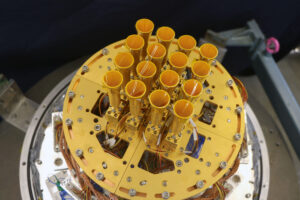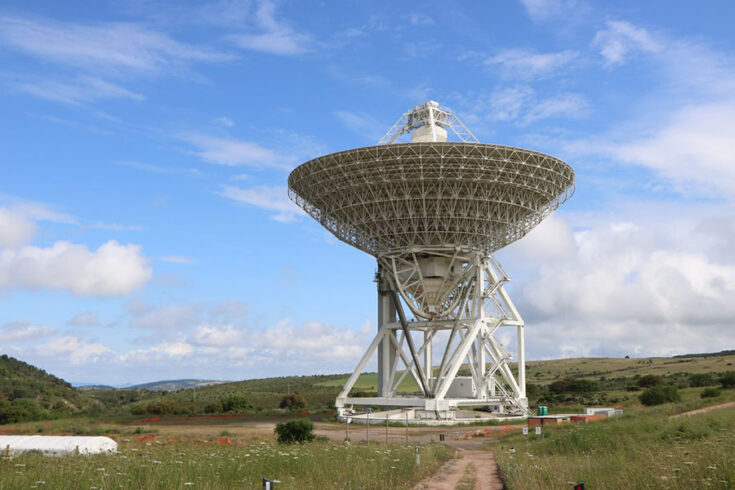This new tool called the Cryogenic Array Receiver for Users of the Sardinia Observatory (CARUSO), is an instrument which will enable the telescope to pick up entirely new signals from space.
CARUSO was designed and constructed by the Science and Technology Facilities Council (STFC) RAL Space Millimetre Wave Technology Group (MMT Group), STFC Technology Department, and partners from The University of Manchester.
It is hoped that CARUSO will open new avenues of research at the internationally renowned Italian radio telescope.
Exploring the universe
The Sardinia Radio Telescope is a single-dish radio telescope approximately half the size of the London Eye located in the south Sardinian countryside.
It is owned by the Italian National Institute of Astrophysics and has played an important role in astronomical discovery since its construction in 2012. This includes work which has furthered our understanding of black holes and helped track space debris orbiting Earth.
Its large dish is designed to collect radio waves with a variety of frequencies transmitted from space. These are then picked up and analysed by advanced scientific instruments to infer information about celestial objects, such as galaxies, pulsars, black holes, and other phenomena that emit radio waves.
Generating new frequencies

CARUSO
Credit: STFC RAL Space
One issue faced by the scientists and engineers who use and operate the Sardinia Radio Telescope is how to maximise the information contained within the radio signals it receives.
The RAL Space MMT Group have been employed as they are experts at addressing issues such as this through the design, development, and deployment of millimetre wave instruments such as CARUSO which enable telescopes to pick up more precise signals.
CARUSO uses heterodyne technology to convert and manipulate radio frequencies. This is a type of signal processing which works by combining two radio frequencies to generate a new frequency called an intermediate frequency. This frequency is generally lower and makes signal processing much more manageable.
To capture extremely faint radio signals from outer space, the instrument is chilled to a temperature just 20 Kelvin higher than absolute zero, approximately minus 250 degrees Celsius. This was only achievable through the expertise of the STFC Technology Department who designed and built a mechanically cooled cryostat.
Astronomical aspirations
It is hoped that the new observing modes that CARUSO will enable will allow astronomers to capture images of activity on the sun such as solar flares, with the possibility of space weather forecasting.
CARUSO will also aid in galactic and extragalactic (beyond the Milky Way) research as it will increase the ability of the Sardinia Radio Telescope to observe cold regions of space including crucial star-forming regions.
A group effort
Graham Marshall, CARUSO Project Manager at RAL Space said:
I’m really proud of this milestone for the entire CARUSO team. It’s been a huge group effort between ourselves, the University of Manchester, STFC’s Technology group and the Italian National Institute for Astrophysics (INAF), to get this instrument designed, tested and installed onto the telescope, and we’re all very excited to hear about the first astronomical observations made.
It has been a pleasure working so collaboratively with INAF and I look forward to working on further projects in the future.
Professor Peter Huggard, Millimetre Wave Technology Group Leader at RAL Space, said:
STFC RAL Space and Technology Department colleagues, together with staff at The University of Manchester, have worked really hard together over several years to achieve this excellent milestone.
As a state-of-the-art millimetre wave camera, the highest frequency instrument on the telescope, CARUSO will be used extensively by astronomers in coming years. The team can be justifiably proud of their major contribution to ground-based astronomy.

